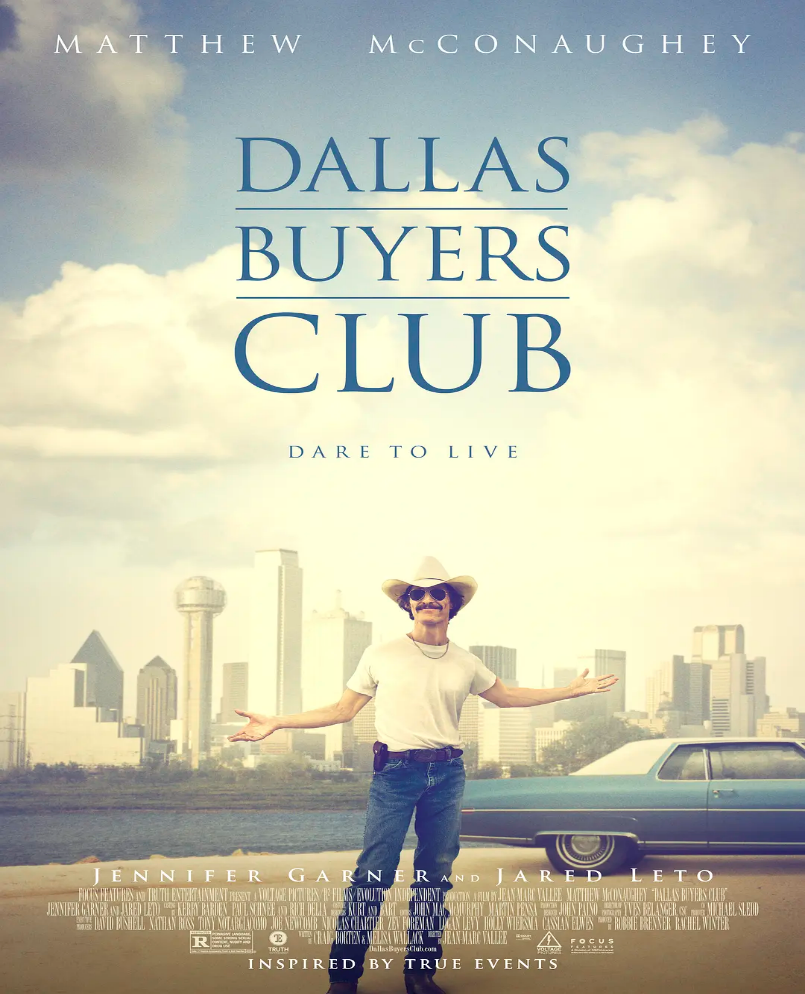Ron Woodruff isn’t really a cowboy who rides a horse and tends a ranch and looks after thousands of beef or dairy cattle. He lived in a cheap mobile home in the Texas city of Dallas and was an electrician by profession, but he followed cowboy culture, such as attending rodeos, and did well. He smoked, drank, took drugs, and occasionally sought pleasure in the hidden corners of the rodeo grounds while having two girls by his side.
In his attitude toward homosexuality, Ron was also highly aligned with those who sought the cowboy style; he hated, loathed, and stayed away. In mid-1980s America, however, he had the misfortune of contracting AIDS – then considered an incurable disease unique to homosexuals – with a sense of dismay comparable, I think, to the sudden discovery of fog by residents of the Swiss Alps. Ron’s first reaction was that the hospital had confused his blood samples with those of a gay man, whom he referred to with the disparaging term “daisy puller.
The doctor’s diagnosis was not optimistic, and Ron only had a 30-day life expectancy. The movie “Dallas Buyers Club” (Dallas Buyers Club) was on the clock at this point, starting from day one. Ron was a real person, and the movie was recreated based on a report in a local Dallas newspaper. His life didn’t change that day, he still smoked, drank, did drugs and got girls, keeping the number at 2 at the same time. He may not have realized that he was probably passing the HIV virus to two people at the same time.
It was a day in July 1985. The movie shows many sights that have largely faded from today’s society, such as people going to the library to look up historical information through microfilm, driving boat-shaped blue Dodge cars, using brick-like thick cell phones, smoking in hospital buildings, listening to songs on cassette tapes, and so on. There are also things that remain the same, like always having a pool table in the bar. Deeper and more constant is the animal’s instinct to survive.
The hospital offered the experimental drug AZT only to a very small number of patients, Ron was not one of them, but he refused to wait to die. After traveling south to Mexico, he found a doctor whose license had been revoked in the United States. This doctor figured out a primitive cocktail regimen that was quite effective, including zinc, aloe vera, vitamins, nutritional supplements and an antiviral that had not yet been approved by the government. After taking it, Ron survived far longer than the doctor expected, and he immediately turned the power of his example into a business opportunity: If I can survive, so can you. Hundreds of people joined the club he founded, paying $400 a month for a cocktail with Ron’s twist. Sometimes the cocktails worked, sometimes they didn’t, and no one could fully understand their efficacy or toxicity, but that didn’t stop the club from growing. Ron found a modest motel to work in, and there was never a long line outside his room. At the time, the spread of AIDS in the United States was the equivalent of an epidemic.
Some of the ingredients needed in Ron’s folk formula were controlled substances in the United States, and he had to go to Mexico to purchase them illegally, or purchase them legally from places like Japan and then bring them into the United States illegally. As seen in the movie, formal research departments like hospitals are also seeking effective treatments, only with a slightly more conservative mindset and far less urgency to solve the problem than the patients themselves. In addition, few people can afford the $10,000 per year cost of treatment. Patients with other difficult diseases actually face the same pattern and are presumably left with the only option of passively accepting it. In contrast, AIDS patients were significantly different in at least two ways. First, they were numerous and also, because of the high percentage of homosexuals among them, easily organized to form a group force. Second, there were indeed some Rone-like brands of folk formulas that worked better than formal hospital treatment at the time. As a result, a special wave of large-scale civil resistance formed in the United States from the mid-1980s to the early 1990s, namely medical activism, a rights movement centered on the collective search for medical care by AIDS patients.
The 2012 documentary “How To Survive A Plague” recalls that history in detail. Realizing that staying silent was tantamount to waiting for death, people living with AIDS tried desperately to speak out, using marches, rallies, sit-ins and other means to make their plight known to society at large. Their emotions could be summarized as “mixed feelings of grief and anger,” both from their own misfortune of having the disease and from the lack of social understanding. At that time, the United States was under Reagan’s administration, and conservative thinking was becoming dominant, so not many people could objectively understand homosexuality. In the documentary, George Bush Sr. and Senator Helms, who followed Reagan as president, believe that the cause of AIDS is misconduct and that the best way to eradicate the disease is to remain chaste.
The “outrage” was mainly due to government inaction. I have lived in the Washington, D.C. area for more than 10 years and have never heard of a mass incident in front of the National Institutes of Health (NIH), which is at the forefront of medical research and should be a place of hope for people. In the documentary, the front of this federally run institution has become a major venue for rallies of AIDS patients who feel that the NIH has failed to provide effective solutions in a more aggressive manner sooner. Objectively speaking, the U.S. health administration itself is not greatly at fault; the government has never been more concerned with procedural compliance and does not make adjustments easily out of compassion.
The documentary “The Plague Survival Guide” reflects a time that largely overlaps with “Dallas Buyers Club” and is very close in spirit. Ron and the surrounding AIDS patients do not rely on the government; they rely on self-education and self-rescue. In the process, the whole society’s perception of AIDS and homosexuality gradually changed. Ron’s business partner Rayon is as handsome as Brad Pitt on the outside, but deep down he wants to be Angelina Jolie. At first Ron has only a negative view of his gender dysphoria and homosexuality, but as their relationship deepens, Ron’s attitude begins to change and he gives more understanding to Rayon, a gentle, kind and funny partner who wears dresses, lipstick and high heels. There is a scene in the movie inside a grocery store where an old friend Ron meets refuses to shake Rayon’s hand, which is different from Dulles’ refusal to shake Zhou Enlai’s hand, but the discrimination contained therein still has a connection. At this point Ron resorts to coercion, and the old friend’s hand is forced to produce contact with Rayon’s.
Many people’s views on homosexuality have changed through a similar path to Ron’s. Not long ago I interviewed Evan Wolfson, a prominent gay rights lawyer in New York, and he said the same thing: If you have the opportunity to interact with a gay person in real life, or if you have friends or family who are gay, you will probably find that they are just as hard-working, hard-working, and successful as heterosexuals, except for their sexual orientation, which is determined by genes and other factors.
The movie ends with the timer “Day 2557”, the end of Ron’s tenacious battle with death, which was 1992. 1996 was the year when a real breakthrough was made in protease inhibitor research and anti-retroviral drugs came into maturity, after which the death rate from AIDS began to drop dramatically. To this day, there is still no cure for AIDS, but with enough money to pay for treatment, this once terminal disease has become a chronic disease that can be effectively managed, and the contribution of the Ron’s cannot be ignored, as one rights activist says at the end of the documentary “A Guide to Surviving the Plague”, the government didn’t give us the drugs, others didn’t give us the drugs, we the people with AIDS fought for the drugs ourselves. This is the proudest achievement the gay community has ever had.
There are still a few people in American society who refuse to recognize homosexuality, but there is no doubt that we are in an increasingly tolerant atmosphere. By 2013, 18 U.S. states and Washington, D.C., had officially recognized same-sex marriage in law. In my opinion, of all the direct quotes that have appeared in the media this year, Pope Francis, when asked what he thought of homosexuality, said, “Who Am I To Judge?” (Who Am I To Judge?) may have been the most comforting to gays and lesbians. The fact that the Roman Catholic Church, which has always taken a conservative stance on homosexuality, has also relented should indicate that society’s understanding of homosexuality is continuing to move in a humane direction.

